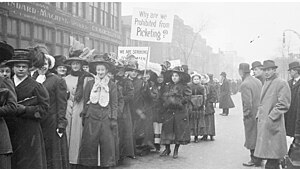The 1910 Chicago garment workers' strike, also known as the Hart, Schaffner and Marx (HSM) strike, was a labor strike established and led by women in which diverse workers in the garment industry showed their capability to unify across ethnic boundaries in response to an industry's low wages, unrealistic production demands, and poor working conditions. The strike began on September 22, led by 17-year old Hannah Shapiro, with sixteen women protesting the establishment of a bonus system that demanded high production rates, while also cutting in the piece rate by ¼ cent. Eventually up to 41,000 workers walked out at the peak of the strike. The strike was initially supported by the United Garment Workers (UGW), however the UGW withdrew its support in December over issues of settlement and the strike came to a halt when a deal was agreed upon between the labor leader Sidney Hillman (who later married strike leader Bessie Abramovitch) and HSM in January 1911. Although the most militant strikers held out until February 18, the strike succeeded in getting Rate Committee mandated contracts that presented workers with improved wages and conditions.[1]

